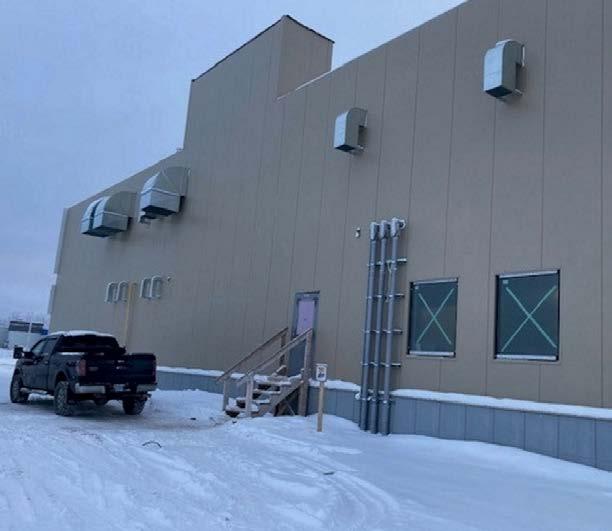
3 minute read
NWT fishery ‘small and shrinking’
Payout to fishers drops by six per cent; new Hay River fish plant to be run by Winnipeg-based marketing corporation for 3 years
By Derek Neary Northern News Services
The territorial government has $450,000 in place for the NWT’s commercial fishery in 2023-24, less than the $600,000 budgetted last year.
The money is intended to offset high freight and production costs.
The territorial government acknowledges that the NWT’s commercial fishery is “small and shrinking.”
Payouts to fishers through the Winnipeg-based Freshwater Fish Marketing Corporation, which purchases NWT product, dropped to $435,000 in 2022, a six per cent reduction from 2021.
There were only 27 active fishers in the territory last year, which the GNWT attributed, in part, to the Covid-19 pandemic. The coronavirus “disrupted trade and depressed demand,” the GNWT’s 2022-23 Economic Review states, noting five straight years of decline in the industry, including three years prior to Covid.
The Department of Industry, Tourism and Investment provided financial assistance in the amount of $564,373 through the Commercial Fishery Assistance Industry Support fund in 2021-22. The vast majority — $424,564 — went to the Tu’Cho Fishers Cooperative for items such as freight support and administrative costs, purchasing a truck to haul fish, covering costs to keep the fish plant open during the fall of 2021 and winter of 2022, and assisting with human resources and contractor fees.
The department spent $205,000 in support for individual fishers — calculated at $0.23 per pound for lake whitefish, lake trout, Northern pike and walleye — to offset shipping costs for NWT fish sent to the Freshwater Fish Marketing Corporation (FFMC) plant in Winnipeg.
The corporation, which also takes in catches from the Great Lakes, admits to challenges of its own in its 2021-22 annual report due to smaller fish deliveries causing “increasing operating costs per kilogram, and decreasing processing efficiency.”
The FFMC also blames the pandemic for disruptions. The volume of fish delivered in 2022 was 14 per cent below the expected 11.3 million kilograms.
Favourable news came from the
FFMC’s sales revenue, which, at $19.4 million, was 38 per cent higher than 2021 and 24 per cent higher than the 2022 estimate. This was attributed to a return in demand for the products. However, it only left the FFMC with a profit of $700,000 before taxes and the final payment made to fishers, who received a 39 per cent return overall.
Hay River fish plant
A new $15-million, 1,600-squarefoot fish plant in Hay River, built by Arctic Canada Construction, was expected to open in June.
The GNWT announced in May that the Freshwater Fish Marketing Corporation will operate the facility for three years, to enable training and capacity building for the operation to be run locally.
The corporation’s 2021-22 annual report makes mention of the impending new fish plant in Hay River, but as the owners of the old plant, the FFMC didn’t seem to have a clear vision of what the future would hold at that time.
“The corporation plans to divest of its facility and land in Hay River by the end of 2023. With the support of Crown-Indigenous Relations and Northern Affairs Canada, FFMC is currently consulting with Indigenous groups in the area regarding the future of FFMC’s Hay River assets,” the report reads.
Industry, Tourism and Investment Minister Caroline Wawzonek acknowledged in the legislative assembly in late May that the territorial government was continuing its
— with 367 of them being direct employees.
Wages paid in 2018 were estimated at $31.7 million. The association comprises the Arctic Fishery Alliance, Baffin Fisheries, Pangnirtung, Fisheries/Cumberland Sound Fisheries Partnership and the Qikiqtaaluk Fisheries Corporation.
More collaboration
In February, the Government of Nunavut signed a memorandum of understanding with government leaders in Newfoundland and Labrador to work cooperatively in developing their natural resources, including fisheries; internet infrastructure; transportation; tourism; healthcare; addressing climate change; transportation; and workforce training.
The two governments agreed to strike a committee that will set out a framework for cooperation and coordination between the governments in “areas of mutual interest.”
fact FILE
Data For Catch And Prices Paid In 2022
Walleye (pickerel): 4.2 million kilograms at $3.74 per kg for a total of $15.7 million
Whitefish: 2.2 million kilograms at $2.41 per kg for a total of $5.3 million
Northern pike: 900,000 kilograms at $1.11 per kg for a total of $1 million
Source: Freshwater Fish Marketing Corporation dialogue with the Tu’Cho Fishers Co-operative, a group of South Slave Indigenous fishers, to find common ground on fish production and raising the price of fish for industry participants in the NWT.
The GNWT also held fisheries training programs in Hay River and Yellowknife this past March, with additional sessions scheduled in June for Hay River, Fort Resolution and Yellowknife.
“The program gives new fishers the skills and knowledge to have successful winter harvests and presents an opportunity to expand fishing operations year-round once fishers get established,” said Wawzonek.

